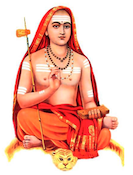A brief history of Adi Shankaracharya

Introduction
Adi Shankaracharya (ca. 788–820 CE) was one of the most influential spiritual masters in Indian history. A philosopher, theologian, and reformer, he revived Hinduism at a time when it was fragmented by ritualism and conflicting sects. He is best known for consolidating the Advaita Vedanta philosophy, which teaches the oneness of the individual soul (Atman) and the Supreme Reality (Brahman).Early Life and Birth
Shankara was born in the village of Kaladi in present-day Kerala, India, to a pious Nambudiri Brahmin couple, Shivaguru and Aryamba, after years of prayer and austerities. His exact birth date is debated, but traditional accounts place it in the 8th century CE. His mother played a major role in shaping his early spiritual inclinations, teaching him the scriptures from a young age.Shankara displayed astonishing intelligence and memory even as a child. He mastered the Vedas, Upanishads, and other Sanskrit texts by the age of eight and showed a strong desire to renounce worldly life.
Renunciation and Guru
Despite his mother’s initial resistance, Shankara became a sannyasi (monk) at a young age, following a dramatic incident in which he was nearly killed by a crocodile while bathing in a river. According to legend, he used this moment to convince his mother that only through renunciation could he fulfill his spiritual mission.He traveled north in search of a guru and found Govinda Bhagavatpada, a disciple of the great sage Gaudapada. Under his guidance, Shankara deepened his understanding of Advaita Vedanta, the non-dualistic interpretation of the Vedic texts.
Travels and Debates
After completing his studies, Shankara began a remarkable journey across India, engaging in philosophical debates with scholars of various schools of thought. These included followers of Mimamsa, Samkhya, Yoga, Nyaya, Buddhism, and Jainism.His most famous debate was with Mandana Mishra, a respected Mimamsa scholar. Mandana’s wife Ubhaya Bharati, who was also a scholar, served as judge. After a long and rigorous discussion, Mandana accepted defeat and became one of Shankara’s disciples, later known as Sureshvaracharya.
These debates were not merely intellectual exercises—they were meant to revive and unify Hindu philosophical thought and refute ideas that Shankara saw as divergent from the essential Vedic truth.
Core Philosophy: Advaita Vedanta
Shankara's central teaching was Advaita or non-dualism, which asserts that:- Brahman is the only ultimate reality
- The world of names and forms (the material world) is Maya (illusion)
- The individual soul (Atman) is not separate from Brahman; it is identical to it
- Liberation (moksha) comes not through rituals, but through self-knowledge and realization of the non-dual nature of reality
He emphasized jnana yoga (path of knowledge) over ritualistic worship and taught that scriptures should be interpreted with a deep understanding of their inner, symbolic meanings.
Major Works
Adi Shankara was a prolific writer. His most important works include:- Bhashyas (Commentaries):
- On the Upanishads
- On the Bhagavad Gita
- On the Brahma Sutras (his Brahmasutra Bhashya is considered the definitive Advaita interpretation)
- Prakaranas (Independent Treatises):
- Vivekachudamani “Crest-jewel of Discrimination”
- Atma Bodha “Knowledge of the Self”
- Tattva Bodha “Knowledge of Reality”
- Upadesa Sahasri “A Thousand Teachings”
- Stotras (Hymns):
- Bhaja Govindam
- Dakshinamurti Stotra
- Soundarya Lahari (debated attribution)
These texts continue to be studied and revered by spiritual seekers and scholars alike.